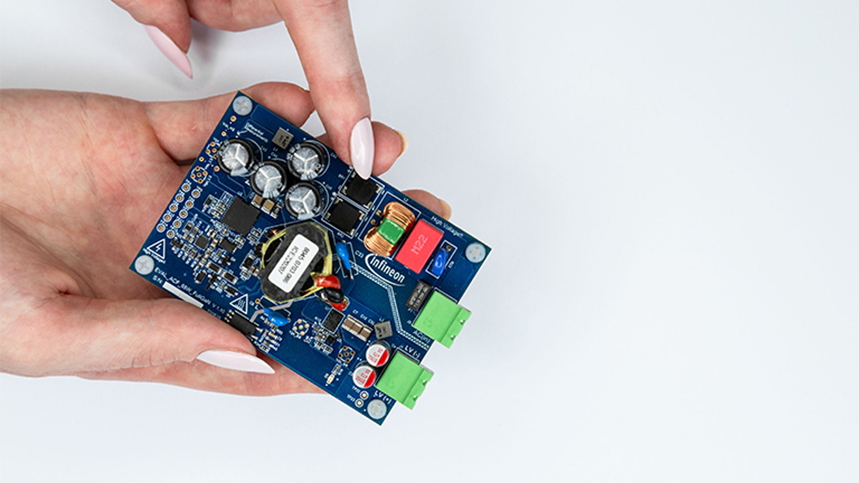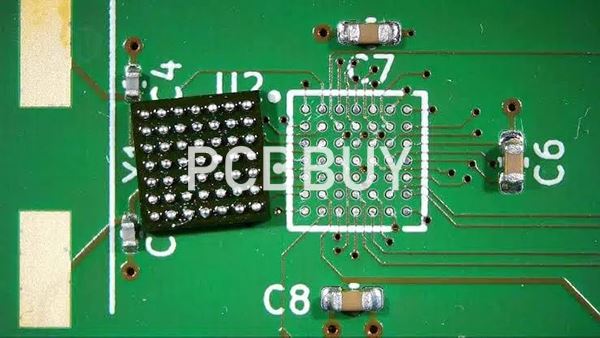Ground Line Design Considerations in PCB Design
By:PCBBUY 03/19/2024 10:41

Ground Line Design Considerations in PCB Design
1. Common Impedance Interference of Ground Lines in PCB Design
The ground line on the circuit diagram represents the zero potential of the circuit and serves as a common reference point for other points in the circuit. In practical circuits, due to the impedance of the ground line (copper foil line), common impedance interference is inevitable. Therefore, when routing, points with ground line symbols cannot be arbitrarily connected together, as this may cause harmful coupling and affect the normal operation of the circuit.
2. How to Connect Ground Lines in PCB Design
Ground lines in an electronic system are typically divided into several types, such as system ground, chassis ground (shield ground), digital ground (logic ground), and analog ground. When connecting ground lines, the following points should be noted:
1) Correctly choose single-point grounding and multipoint grounding
In low-frequency circuits where the signal frequency is less than 1MHz, the inductance between routing and components can be ignored, but the voltage drop on the ground line circuit resistance has a significant impact on the circuit. Therefore, the single-point grounding method should be adopted. When the signal frequency exceeds 10MHz, the influence of ground line inductance is significant, so it is advisable to use multipoint grounding close to the circuit. When the signal frequency is between 1~10MHz, if the single-point grounding method is adopted, the length of the ground line should not exceed 1/20 of the wavelength, otherwise multipoint grounding should be used.

2) Separate Digital and Analog Grounds
On the circuit board, there are both digital circuits and analog circuits, and they should be separated as much as possible, and ground lines should not be mixed. They should be respectively connected to the ground terminals of the power supply (ideally, also separately connected at the power supply end). The area of linear circuits should be maximized. Generally, digital circuits have strong anti-interference ability, with a noise tolerance of 0.4~0.6V for TTL circuits and 0.3~0.45 times the power supply voltage for CMOS digital circuits, while the analog circuit section can be affected by noise at the microvolt level, which is enough to make it work abnormally. Therefore, the two types of circuits should be laid out and wired separately.
3) Make Ground Lines as Thick as Possible
If the ground line is too thin, the ground potential will vary with the change of current, causing interference to the electronic system, especially the analog circuit part. Therefore, the ground line should be made as wide as possible, generally greater than 3mm is appropriate.
4) Form Ground Loops
When there are only digital circuits on the circuit board, the ground line should be formed into a loop, which can significantly improve the anti-interference ability. This is because when there are many integrated circuits on the circuit board, if the ground line is very thin, it will cause a large ground potential difference, while the loop ground line can reduce the ground resistance, thereby reducing the ground potential difference.
5) Ground points of the same level of circuitry should be as close as possible, and the power supply filtering capacitors of this level should also be connected to the ground points of this level.
6) Connection of Overall Ground Line
The overall ground line must be strictly connected from weak electricity to strong electricity in order of high frequency, medium frequency, and low frequency. It is best to use a large-area surround ground line for the high-frequency part to ensure good shielding effect.
Ground Line Definition
What is a ground line? The definition of a ground line learned from textbooks is: a ground line is an equipotential body serving as a reference potential point for a circuit. This definition does not conform to the actual situation. The potential on the actual ground line is not constant. If you measure the potential between points on the ground line with an instrument, you will find that the potential difference between points on the ground line may be very large. It is these potential differences that cause abnormal operation of the circuit. The definition of a ground line as an equipotential body is only an expectation of the potential of the ground line by people. HENRY gave a more realistic definition of a ground line: a low-impedance path for signal return to the source. This definition emphasizes the flow of current in the ground line. According to this definition, it is easy to understand the reason for the potential difference in the ground line. Because the impedance of the ground line is never zero, when a current passes through a finite impedance, a voltage drop will occur. Therefore, we should imagine the potential on the ground line as waves in the sea, fluctuating up and down.
Impedance of Ground Line
When it comes to the potential difference between points on the ground line caused by the impedance of the ground line, many people find it incredible: when we measure the resistance of the ground line with an ohmmeter, the resistance of the ground line is often in the milliohm range. How can such a small resistance produce such a large voltage drop when the current flows through it, leading to abnormal operation of the circuit? To clarify this issue, we need to distinguish between the resistance and impedance of conductors, two different concepts. Resistance refers to the impedance presented by the conductor to the current in the DC state, while impedance refers to the impedance of the conductor to the current in the AC state, which is mainly caused by the inductance of the conductor. Any conductor has inductance. When the frequency is high, the impedance of the conductor is much greater than the DC resistance, as shown in Table 1. In practical circuits, the interfering signals that cause electromagnetic interference are often pulse signals, which contain rich high-frequency components, so they will produce large voltage on the ground line.

Table 1 Impedance of Conductors (Ω):
Frequency
Hz D = 0.65
10cm 1m D = 0.27
10cm 1m D = 0.065
10cm 1m D = 0.04
10cm 1m 10 51.4m 517m 327m 3.28m 5.29m 52.9m 13.3m 133m 1k 429m 7.14m 632m 8.91m 5.34m 53.9m 14m 144m 100k 42.6m 712m 54m 828m 71.6m 1.0 90.3m 1.07 1M 426m 7.12 540m 8.28 714m 10 783m 10.6 5M 2.13 35.5 2.7 41.3 3.57 50 3.86 53 10M 4.26 71.2 5.4 82.8 7.14 100 7.7 106 50M 21.3 356 27 414 35.7 500 38.5 530 100M 42.6 54 71.4 77 150M 63.9 81 107 115
If the impedance at
10Hz is approximately considered as DC resistance, it can be seen that when the frequency reaches 10MHz, for a 1-meter-long conductor, its impedance is 1000 times to 100,000 times that of the DC resistance. Therefore, for RF currents, when the current flows through the ground line, the voltage drop is very large. From the table, it can also be seen that increasing the diameter of the conductor is very effective in reducing the DC resistance, but it has limited effect on reducing the AC impedance. However, in electromagnetic compatibility, people are most concerned about AC impedance. An effective way to reduce AC impedance is to parallel multiple conductors. When two conductors are connected in parallel, the total inductance L is:
L = ( L1 + M ) / 2
Where L1 is the inductance of a single conductor, and M is the mutual inductance between the two conductors. It can be seen from the formula that when the two conductors are far apart, the mutual inductance between them is small, and the total inductance is equivalent to half of the inductance of a single conductor. Therefore, we can reduce the ground impedance by using multiple grounding wires in parallel. However, it should be noted that the distance between multiple conductors should not be too close.
Ground Interference Mechanism
3.1 Ground Loop Interference
Figure 1 shows two grounded circuits. Due to the impedance of the ground line, when a current flows through the ground line, a voltage will be generated on the ground line. When the current is large, this voltage can be very large. For example, when a nearby high-power appliance is started, a very strong current flows through the ground line. This current will generate a current on the connection cable between the two devices. Due to the imbalance of the circuit, the currents on each wire are different, thus generating common-mode voltage, which affects the circuit. Since this interference is caused by the loop current formed by the cable and the ground line, it is called ground loop interference. The current in the ground loop can also be induced by an external electromagnetic field.
3.2 Common Impedance Interference
When two circuits share a section of the ground line, due to the impedance of the ground line, the ground potential of one circuit will be modulated by the operating current of another circuit. In this way, a signal from one circuit is coupled into another circuit, which is called common impedance coupling.
In digital circuits, the ground line often exhibits a large impedance due to the high signal frequency. In this case, if different circuits share a section of the ground line, the problem of common impedance coupling may occur. Example in Figure 3 illustrates an interference phenomenon. Figure 3 shows a simple circuit composed of four gate circuits. Assuming that the output level of gate 1 changes from high to low, the parasitic capacitance in the circuit (sometimes the input of gate 2 has a filtering capacitor) will discharge through gate 1 to the ground line. Due to the impedance of the ground line, the discharge current will generate a spike voltage on the ground line. If at this time, the output of gate 3 is at a low level, this spike voltage will be transmitted to the output of gate 3 and the input of gate 4. If the amplitude of this spike voltage exceeds the noise threshold of gate 4, it will cause misoperation of gate 4.

Ground Interference Countermeasures
4.1 Ground Loop Countermeasures
From the mechanism of ground loop interference, it can be known that reducing the current in the ground loop can reduce ground loop interference. If the current in the ground loop can be completely eliminated, ground loop interference can be completely solved. Therefore, we propose the following solutions to solve ground loop interference.
A. Float one end of the device If one end of the circuit is floated, the ground loop is cut off, which can eliminate ground loop current. However, there are two problems to note. One is for safety reasons, circuit floating is often not allowed. In this case, consider grounding the equipment through an inductor. In this way, the ground impedance of the device is very small for 50Hz AC current, while for high-frequency interference signals, the ground impedance of the device is relatively large, reducing the ground loop current. But doing so can only reduce the ground loop interference of high-frequency interference. Another problem is that even if the device is floated, there is still parasitic capacitance between the device and the ground, which provides a low impedance at high frequencies, so it cannot effectively reduce high-frequency ground loop current.
B. Use transformers to connect between devices Using magnetic circuits to connect two devices can cut off the ground loop current. However, it should be noted that the parasitic capacitance between the primary and secondary of the transformer can still provide a path for high-frequency ground loop current, so the method of isolating transformers has poor suppression effect on high-frequency ground loop current. One way to improve the high-frequency isolation effect of transformers is to set a shield layer between the primary and secondary of the transformer. But it must be noted that the grounding end of the shielded transformer must be at one end of the receiving circuit. Otherwise, it will not only fail to improve the high-frequency isolation effect, but may also aggravate high-frequency coupling. Therefore, the transformer should be installed on the side of the signal receiving device. A well-shielded transformer can provide effective isolation at frequencies below 1MHz.
C. Use optocouplers Another method to cut off ground loop is to use light to transmit signals. This can be said to be the most ideal method to solve ground loop interference. There are two methods of using light to connect, one is optoelectronic devices, and the other is to use optical fibers for connection. The parasitic capacitance of optocouplers is generally 2pF, which can provide good isolation at very high frequencies. Optical fibers have almost no parasitic capacitance, but installation, maintenance, and cost are not as good as optocouplers.
D. Use common mode chokes on connecting cables Using common mode chokes on connecting cables effectively increases the impedance of the ground loop, so the ground loop current will be reduced under a certain ground line voltage. But it should be noted that controlling the parasitic capacitance of common mode chokes, otherwise the isolation effect on high-frequency interference will be poor. The more turns of the common mode choke, the larger the parasitic capacitance, and the worse the isolation effect of high-frequency.

4.2 Elimination of Common Impedance Coupling
There are two ways to eliminate common impedance coupling. One is to reduce the impedance of the common ground line part, so that the voltage on the common ground line is also reduced, thereby controlling common impedance coupling. The other method is to avoid easy interference between circuits by appropriate grounding methods, such as sharing ground lines between strong electric circuits and weak electric circuits, and sharing ground lines between digital circuits and analog circuits. As mentioned earlier, the core issue of reducing ground impedance is to reduce ground inductance. This includes using flat conductors as ground lines, and using multiple parallel conductors with a distance for grounding lines. For printed circuit boards, grounding grids on double-layer boards can effectively reduce ground line impedance, and using one layer specifically for grounding lines on multilayer boards, although it has a very small impedance, will increase the cost of
the PCB. Avoiding common impedance coupling by proper grounding methods is to parallel single-point grounds, as shown in Figure 4. The disadvantage of parallel grounding is that there are too many grounding wires. Therefore, in practice, it is not necessary for all circuits to parallel single-point ground. For circuits with less mutual interference, serial single-point grounding can be used. For example, circuits can be classified according to strong signals, weak signals, analog signals, and digital signals, and serial single-point grounding can be used within the same type of circuits, and parallel single-point grounding can be used for different types of circuits.
Conclusion
The main reason for ground interference is the impedance of the ground line. When a current flows through the ground line, a voltage will be generated on the ground line, which is ground noise. Under the drive of this voltage, a ground loop current will be generated, forming ground loop interference. When two circuits share a section of the ground line, common impedance coupling occurs. The solution to ground loop interference includes cutting off the ground loop, increasing the impedance of the ground loop, and using balanced circuits. The solution to common impedance coupling is to reduce the impedance of the common ground line part or use parallel single-point grounding to completely eliminate common impedance. When grounding, attention should be paid to the following issues: 1. The grounding resistance should be less than 100 ohms. 2. The grounding wire should be as thick as possible, generally using a wire larger than 8mm for grounding. 3. Ground lines should be avoided as much as possible from strong electric circuits and main circuit wires. When it cannot be avoided, they should intersect vertically and the parallel length should be minimized. 4. Ensure correct grounding, pay attention to shielding, etc. Usually, signal lines and power lines are separated for wiring, and power cables need to be wired separately. Signal lines should be placed as close to the ground line as possible or enclosed by the ground line.
Industry Category











